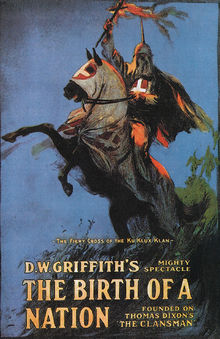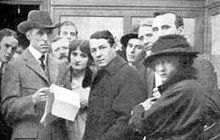The Birth of a Nation
| The Birth of a Nation | |
|---|---|
 Poster iklan filem | |
| Pengarah | D. W. Griffith |
| Lakon layar | D. W. Griffith Frank E. Woods |
| Berdasarkan | The Clansman oleh T. F. Dixon Jr. |
| Dihasilkan oleh | D. W. Griffith Harry Aitken[1] |
| Dibintangi | Lillian Gish Mae Marsh Henry B. Walthall Miriam Cooper Ralph Lewis George Siegmann Walter Long |
| Sinematografi | G. W. Bitzer |
| Disunting oleh | D. W. Griffith |
| Muzik oleh | Joseph Carl Breil |
Syarikat penerbitan | David W. Griffith Corp. |
| Diedarkan oleh | Epoch Producing Co. |
Tarikh tayangan |
|
Masa tayangan | 12 gelung 133–193 minutes[2] |
| Negara | AS |
| Bahasa | Bisu |
| Bajet | >$100,000[3] |
| Pecah panggung | unknown; estimated $50–100 million[4] |

The Birth of a Nation (asalnya dipanggil The Clansman) merupakan filem senyap epik Amerika Syarikat 1915 yang diarahkan dan diterbitkan oleh D. W. Griffith serta dibintangi oleh Lillian Gish. Ia merupakan adaptasi dari novel dan pementasan The Clansman, oleh Thomas Dixon Jr.. Filem ini ditulis oleh Griffith bersama-sama Frank E. Woods.
Filem ini menjadi penuh kontroversi atas penampilan watak-watak berkulit hitam ia sebagai berperwatakan ganas (dilakonkan banyak pelakon berkulit putih dalam solekan khas) serta bernafsu buas terhadap wanita, serta menggambarkan Ku Klux Klan - sebuah kelompok pemerjuang ketuanan kulit putih - sebagai wira,[5][6] malah penayangan filem ini menjadi antara faktor penting dalam penaikkan nama serta pembentukan semula kelompom tersebut pada tahun 1915. Terdapat banyak tunjuk perasaan dalam golongan masyarakat kulit hitam terhadap penayangan filem dini di serata Amerika Syarikat.[7]
Barisan pelakon
[sunting | sunting sumber]- Lillian Gish
- Mae Marsh
- Henry B. Walthall
- Miriam Cooper
- Mary Alden
- Ralph Lewis
- George Siegmann
- Walter Long
- Wallace Reid
- Joseph Henabery
- Elmer Clifton
- Josephine Crowell
- Spottiswoode Aitken
- George Beranger
- Maxfield Stanley
- Jennie Lee
- Donald Crisp
- Howard Gaye
Tiada kredit:
- Robert Harron
- Edmund Burns
- David Butler
- William Freeman
- Sam De Grasse
- Olga Grey
- Russell Hicks
- Elmo Lincoln
- Eugene Pallette
- Harry Braham
- Charles Stevens
- Madame Sul-Te-Wan
- Raoul Walsh
- Lenore Cooper
- Violet Wilkey
- Tom Wilson
- Donna Montran
- Alberta Lee
- Allan Sears
- Vester Pegg
- Alma Rubens
- Mary Wynn
- Jules White
- Monte Blue
- Gibson Gowland
- Fred Burns
- Alberta Franklin
- Charles King
- William E. Cassidy
Rujukan
[sunting | sunting sumber]- ^ "D. W. Griffith: Hollywood Independent". Cobbles.com. 1917-06-26. Dicapai pada 2013-07-03.
- ^ "THE BIRTH OF A NATION (U)". Western Import Co. Ltd. British Board of Film Classification. Dicapai pada 20 Ogos 2013.
- ^ Hall, Sheldon; Neale, Stephen (2010). Epics, spectacles, and blockbusters: a Hollywood history. Contemporary Approaches to Film and Television. Wayne State University Press. m/s. 270 (note 2.78). ISBN 978-0-8143-3697-7.
In common with most film historians, he estimates that The Birth of Nation cost "just a little more than $100,000" to produce...
- ^ Monaco, James (2009). How to Read a Film:Movies, Media, and Beyond. Oxford University Press. ISBN 978-0-19-975579-0.
- ^ MJ Movie Reviews – Birth of a Nation, The (1915) by Dan DeVore Diarkibkan 7 Julai 2009 di Wayback Machine
- ^ Armstrong, Eric M. (Februari 26, 2010). "Revered and Reviled: D.W. Griffith's 'The Birth of a Nation'". The Moving Arts Film Journal. Diarkibkan daripada yang asal pada Mei 29, 2010. Dicapai pada April 13, 2010. Unknown parameter
|deadurl=ignored (bantuan) - ^ ""The Birth of a Nation" Sparks Protest". Mass Moments. Diarkibkan daripada yang asal pada Mei 12, 2013. Dicapai pada Julai 3, 2013. Unknown parameter
|deadurl=ignored (bantuan)
Bibliografi
- Addams, Jane, in Crisis: A Record of Darker Races, X (May 1915), 19, 41, and (June 1915), 88.
- Bogle, Donald. Toms, Coons, Mulattoes, Mammies and Bucks: An Interpretive History of Blacks in American Films (1973).
- Brodie, Fawn M. Thaddeus Stevens, Scourge of the South (New York, 1959), p. 86–93. Corrects the historical record as to Dixon's false representation of Stevens in this film with regard to his racial views and relations with his housekeeper.
- Chalmers, David M. Hooded Americanism: The History of the Ku Klux Klan (New York: 1965), p. 30 *Cook, Raymond Allen. Fire from the Flint: The Amazing Careers of Thomas Dixon (Winston-Salem, N.C., 1968).
- Franklin, John Hope. "Silent Cinema as Historical Mythmaker". In Myth America: A Historical Anthology, Volume II. 1997. Gerster, Patrick, and Cords, Nicholas. (editors.) Brandywine Press, St. James, NY. ISBN 978-1-881089-97-1
- Franklin, John Hope, "Propaganda as History" pp. 10–23 in Race and History: Selected Essays 1938–1988 (Louisiana State University Press, 1989); first published in The Massachusetts Review, 1979. Describes the history of the novel The Clan and this film.
- Franklin, John Hope, Reconstruction After the Civil War (Chicago, 1961), p. 5–7.
- Hickman, Roger. Reel Music: Exploring 100 Years of Film Music (New York: W. W. Norton & Company, 2006).
- Hodapp, Christopher L., and Alice Von Kannon, Conspiracy Theories & Secret Societies For Dummies (Hoboken: Wiley, 2008) p. 235–6.
- Korngold, Ralph, Thaddeus Stevens. A Being Darkly Wise and Rudely Great (New York: 1955) pp. 72–76. corrects Dixon's false characterization of Stevens' racial views and of his dealings with his housekeeper.
- Leab, Daniel J., From Sambo to Superspade (Boston, 1975), p. 23–39.
- New York Times, roundup of reviews of this film, March 7, 1915.
- The New Republica, II (March 20, 1915), 185
- Poole, W. Scott, Monsters in America: Our Historical Obsession with the Hideous and the Haunting (Waco, Texas: Baylor, 2011), 30. ISBN 978-1-60258-314-6
- Simkins, Francis B., "New Viewpoints of Southern Reconstruction", Journal of Southern History, V (February, 1939), pp. 49–61.
- Stokes, Melvyn (2007), D. W. Griffith's The Birth of a Nation: A History of "The Most Controversial Motion Picture of All Time", New York: Oxford University Press, ISBN 0-19-804436-4. The latest study of the film's making and subsequent career.
- Williamson, Joel, After Slavery: The Negro in South Carolina During Reconstruction (Chapel Hill, 1965). This book corrects Dixon's false reporting of Reconstruction, as shown in his novel, his play and this film.
Pautan luar
[sunting | sunting sumber]| Wikimedia Commons mempunyai media berkaitan The Birth of a Nation |
- The Birth of a Nation di Pangkalan Data Filem Internet (IMDb)
- The Birth of a Nation: Controversial Classic Gets a Definitive New Restoration Detailed Brenton Film article by Patrick Stanbury on his 2015 restoration, including a history of the film on home video
- The Birth of a Nation at 100 discussion on the BFI's YouTube channel
- The Birth of a Nation boleh didapati untuk muat turun di Internet Archive
- The Birth of a Nation di TCM Movie Database
- (Inggeris) The Birth of a Nation di Allmovie
- The Birth of a Nation di Rotten Tomatoes
- GMU.edu Diarkibkan 2009-11-23 di Wayback Machine, "Art (and History) by Lightning Flash": The Birth of a Nation and Black Protest
- The Birth of a Nation on Roger Ebert's list of great movies
- The Birth of a Nation on filmsite.org, a web site offering comprehensive summaries of classic films
- Souvenir Guide for The Birth of a Nation, hosted by the Portal to Texas History
- Virtual-History.com, Literature
- NEH's EDSITEment lesson plan The Birth of a Nation, the NACCP, and the Balancing of Rights
- C-SPAN hosted discussions of and aired the film on the occasion of its 100th anniversary:
- Q&A interview with Dick Lehr on his book The Birth of a Nation: How a Legendary Filmmaker and a Crusading Editor Reignited America's Civil War, January 11, 2015
- Introduction to screening and discussions, February 14, 2015
- First part of the film
- Intermission with discussion
- Second part of the film
- Open phone discussion with Hari Jones and Dick Lehr
